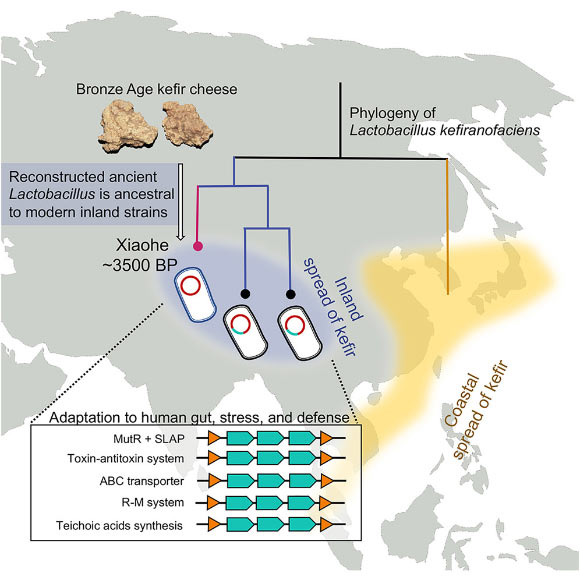Despite the long history of consumption of fermented dairy, little is known about how the fermented microbes were utilized and evolved over human history. By retrieving ancient DNA of 3,500-year-old kefir cheese from Xinjiang, China, Dr. Qiaomei Fu from the Institute of Vertebrate Paleontology and Paleoanthropology at the Chinese Academy of Sciences and colleagues explored past human-microbial interactions. Although it was previously suggested that kefir was spread from the Northern Caucasus to Europe and other regions, the researchers found an additional spreading route of kefir from Xinjiang to inland East Asia.

These 3,500-year-old kefir cheese samples are among the few dairy remains preserved more than 3,000 years and were produced by the Bronze Age Xiaohe population — a population that possesses mixed lifestyles and techniques (e.g., farming, dairy production, hunting, etc.). Also, although early Xiaohe individuals show little genetic interaction with other populations, mitochondrial DNA data suggest maternal connections with East and West Eurasians. By recovering DNA information from ancient fermented dairy remains, Liu et al. investigated the lifestyle linked to the usage of fermented dairy by the Xiaohe population and explore the co-evolution between the fermented bacteria and their hosts. Image credit: Liu et al., doi: 10.1016/j.cell.2024.08.008.
“This is the oldest known cheese sample ever discovered in the world,” said Dr. Fu, senior author of a paper published today in the journal Cell.
“Food items like cheese are extremely difficult to preserve over thousands of years, making this a rare and valuable opportunity.”
“Studying the ancient cheese in great detail can help us better understand our ancestors’ diet and culture.”
The scientists successfully identified cow and goat mitochondrial DNA in the cheese samples from Xinjiang.
Interestingly, the ancient Xiaohe people used different types of animal milk in separated batches, a practice differing from the mixing of milk types common in Middle Eastern and Greek cheesemaking.
Most importantly, the authors managed to recover the DNA of microorganisms from the dairy samples and confirmed that the white substances were in fact kefir cheese.
They discovered that the samples contained bacterial and fungal species, including Lactobacillus kefiranofaciens and Pichia kudriavzevii, both commonly found in present-day kefir grains.
Kefir grains are symbiotic cultures containing multiple species of probiotic bacteria and yeast, which ferment milk into kefir cheese, much like a sourdough starter.
Being able to sequence the bacterial genes in the ancient kefir cheese gave the researchers an opportunity to track how probiotic bacteria evolved over the past 3,600 years.
Specifically, they compared the ancient Lactobacillus kefiranofaciens from the ancient kefir cheese with the modern-day species.
Today, there are two major groups of the Lactobacillus bacteria — one originating East Europe and another from Tibet.
The European type is the most widely used globally, including in the US, Japan, and European countries, for making yogurt and cheese.
The team found that Lactobacillus kefiranofaciens in the samples was more closely related to the Tibetan group, challenging a long-held belief that kefir originated solely in the North Caucasus mountain region of modern-day Europe.
“Our observation suggests kefir culture has been maintained in Northwestern China’s Xinjiang region since the Bronze Age,” Dr. Fu said.
The study also revealed how Lactobacillus kefiranofaciens exchanged genetic material with related strains, improving its genetic stability and milk fermentation capabilities over time.
Compared with ancient Lactobacillus, modern-day bacteria are less likely to trigger an immune response in the human intestine.
This suggests that the genetic exchanges also helped Lactobacillus become more adapted to human hosts over thousands of years of interaction.
“This is an unprecedented study, allowing us to observe how a bacterium evolved over the past 3,000 years,” Dr. Fu said.
“Moreover, by examining dairy products, we’ve gained a clearer picture of ancient human life and their interactions with the world.”
“This is just the beginning, and with this technology, we hope to explore other previously unknown artifacts.”
_____
Yichen Liu et al. Bronze Age cheese reveals human-Lactobacillus interactions over evolutionary history. Cell, published online September 25, 2024; doi: 10.1016/j.cell.2024.08.008


